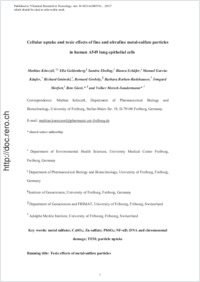Cellular uptake and toxic effects of fine and ultrafine metal-sulfate particles in human A549 lung epithelial cells
- Könczöl, Mathias Department of Environmental Health Sciences, University Medical Center Freiburg, Germany - Department of Pharmaceutical Biology and Biotechnology, University of Freiburg, Germany
- Goldenberg, Ella Institute of Geosciences, University of Freiburg, Freiburg, Germany
- Ebeling, Sandra Department of Pharmaceutical Biology and Biotechnology, University of Freiburg, Germany
- Schäfer, Bianca Department of Pharmaceutical Biology and Biotechnology, University of Freiburg, Germany
- Garcia-Käufer, Manuel Department of Environmental Health Sciences, University Medical Center Freiburg, Germany
- Gminski, Richard Department of Environmental Health Sciences, University Medical Center Freiburg, Germany
- Grobéty, Bernard Department of Geosciences and FRIMAT, University of Fribourg, Switzerland
- Rothen-Rutishauser, Barbara Adolphe Merkle Institute, University of Fribourg, Switzerland
- Merfort, Irmgard Department of Pharmaceutical Biology and Biotechnology, University of Freiburg, Germany
- Giere, Reto Institute of Geosciences, University of Freiburg, Freiburg, Germany
- Mersch-Sundermann, Volker Department of Environmental Health Sciences, University Medical Center Freiburg, Germany
-
01.11.2012
Published in:
- Chemical Research in Toxicology. - 2012, vol. 25, no. 12, p. 2687-2703
English
Ambient airborne particulate matter is known to cause various adverse health effects in humans. In a recent study on the environmental impacts of coal and tire combustion in a thermal power station fine crystals of PbSO4 (anglesite), ZnSO4•H2O (gunningite), and CaSO4 (anhydrite) were identified in the stack emissions. Here, we have studied the toxic potential of these sulfate phases as particulates and their uptake in human alveolar epithelial cells (A549). Both PbSO4 and CaSO4 yielded no loss of cell viability, as determined by the WST-1 and NR assays. In contrast, a concentration-dependent increase in cytotoxicity was observed for Zn sulfate. For all analyzed sulfates, an increase in the production of reactive oxygen species (ROS), assessed by the DCFH-DA assay and Electron Paramagnetic Resonance (EPR), was observed, although to a varying extent. Again, Zn sulfate was the most active compound. Genotoxicity assays revealed concentration-dependent DNA damage and induction of micronuclei for Zn sulfate and, to a lower extent, for CaSO4, whereas only slight effects could be found for PbSO4. Moreover, changes of cell cycle were observed for Zn sulfate and PbSO4. It could be shown further that Zn sulfate increased the nuclear factor kappa-B (NF-κB) DNA binding activity and activated c-Jun N-terminal kinases (JNK). During our TEM investigations, no effect on the appearance of the A549 cells exposed to CaSO4 compared to the non-exposed cells was observed, and in our experiments only one CaSO4 particle was detected in the cytoplasm. In the case of exposure to Zn sulfate, no particles were found in the cytoplasm of A549 cells, but we observed a concentration-dependent increase in the number and size of dark vesicles (presumably zincosomes). After exposure to PbSO4, the A549 cells contained isolated particles as well as agglomerates both in vesicles and in the cytoplasm. Since these metal-sulfate particles are emitted into the atmosphere via the flue gas of coal-fired power stations, they may be globally abundant. Therefore, our study is of direct relevance to the population living near such power plants.
- Faculty
- Faculté des sciences et de médecine
- Department
- Département de Géosciences
- Language
-
- English
- Classification
- Biological sciences
- License
- License undefined
- Identifiers
-
- RERO DOC 30569
- DOI 10.1021/tx300333z
- Persistent URL
- https://folia.unifr.ch/unifr/documents/302611
Statistics
Document views: 67
File downloads:
- gro_cut.pdf: 232
